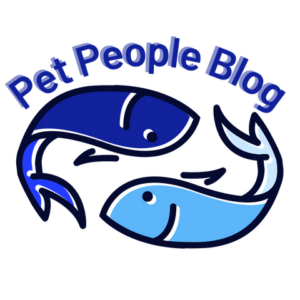If you’re thinking about adding some color and life to your aquarium, Cherry Shrimp might be the perfect choice for you. These small, bright red crustaceans are known for their hardiness, ease of care, and peaceful temperament. Whether you’re a beginner or an experienced aquarist, Cherry Shrimp are a great addition to any freshwater tank.
Cherry Shrimp is a popular freshwater shrimp species that requires a minimum tank size of 5 gallons. They prefer a pH range of 6.5-8.0 and moderately hard water. They are omnivorous and should be fed a varied diet of algae, biofilm, and prepared foods. Regular water changes and proper filtration are necessary for their well-being.
Cherry Shrimp are native to Taiwan and are a popular choice among aquarium enthusiasts. They are easy to care for and can thrive in a variety of water conditions. These shrimp are small, usually growing to about an inch in length, and are known for their bright red coloration. They are also active and social, making them a great addition to a community tank.
I remember when I first added Cherry Shrimp to my tank. I was hesitant at first, but I quickly fell in love with their vibrant colors and playful personalities. Since then, I’ve learned a lot about how to care for these amazing creatures. In this article, we’ll cover everything you need to know about Cherry Shrimp care, from tank setup to feeding, breeding, and more. So, let’s dive in and explore the wonderful world of Cherry Shrimp!
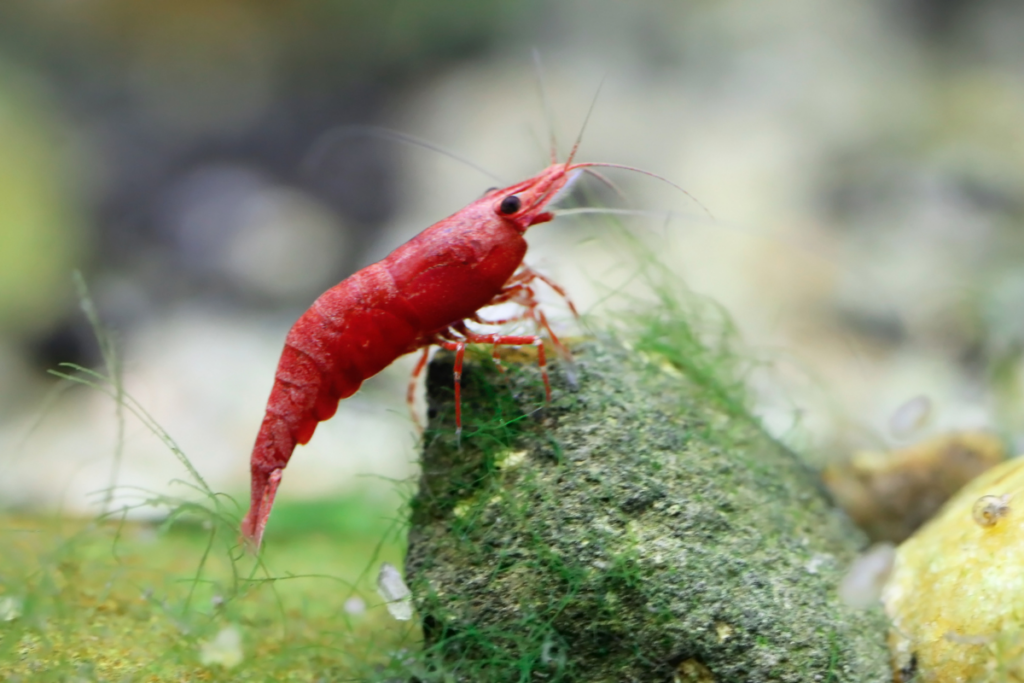
Table of Contents
Species Summary
Origin
Cherry Shrimp (Neocaridina heteropoda var. Red) are freshwater shrimp that originate from Taiwan. They are a selectively bred variant of the wild-type Neocaridina heteropoda. Cherry Shrimp are popular among hobbyists due to their small size, vibrant colors, and ease of care.
Lifespan
Cherry Shrimp have a lifespan of approximately 1-2 years, depending on the quality of care they receive. Factors such as water quality, diet, and stress levels can all impact their lifespan.
Appearance
Cherry Shrimp are small, typically growing to about 1-1.5 inches in length. They have a bright red coloration, which intensifies as they mature. Females tend to be larger and more robust than males. Cherry Shrimp have a transparent exoskeleton, which allows you to see their internal organs.
Size
As mentioned, Cherry Shrimp typically grow to about 1-1.5 inches in length. They are a small species of shrimp, which makes them ideal for nano aquariums and shrimp-only setups.
Growth Rate
Cherry Shrimp have a relatively fast growth rate, reaching maturity at around 6 months of age. They will continue to grow and molt throughout their lifespan, with females growing larger than males.
Behavior & Temperament
Cherry Shrimp are peaceful and social creatures that thrive in groups. They are active and entertaining to watch, often displaying interesting behaviors such as grazing on algae, scavenging for food, and mating rituals.
Cherry Shrimp are generally non-aggressive and can be kept with other peaceful community fish and invertebrates.
Male vs Female
The easiest way to distinguish between male and female Cherry Shrimp is by looking at their underbelly. Females have a curved underbelly, which is used to carry their eggs.
Males have a straighter underbelly and are generally smaller and less colorful than females.
I remember when I first got my Cherry Shrimp, I was amazed at how active and social they were. Watching them graze on algae and interact with each other was incredibly entertaining.
They quickly became one of my favorite species to keep in my aquarium.
Benefits of Cherry Shrimp in Aquarium
Adding cherry shrimp to your aquarium is not only visually appealing but also comes with a range of benefits. Here are some of the reasons why you should consider adding cherry shrimp to your aquarium:
Firstly, cherry shrimp are great algae eaters. They will help keep your aquarium clean by eating up any algae that may grow in your aquarium.
This means that you will have to clean your aquarium less often, which saves you time and effort.
Secondly, cherry shrimp are peaceful creatures that get along with other fish and shrimp species. They are not aggressive and won’t harm other inhabitants in your aquarium.
This means that you can add cherry shrimp to your aquarium without worrying about them causing any harm.
Thirdly, cherry shrimp are easy to care for. They don’t require any special care or attention and can thrive in a range of water conditions. This makes them an ideal choice for beginners who are just starting with aquariums.
Finally, cherry shrimp are beautiful to look at. They come in a range of vibrant colors, including red, yellow, and blue. Watching them swim around your aquarium is a great way to relax and de-stress after a long day.
Personally, I love adding cherry shrimp to my aquarium. They add a pop of color and life to the tank and are incredibly easy to care for. Watching them swim around and interact with other inhabitants is always a joy.
Tank Setup
Setting up the perfect tank for your Cherry Shrimp is crucial for their health and happiness. Here are some things you need to consider:
Tank Size
The tank size you choose will depend on the number of Cherry Shrimp you plan to keep. As a general rule, you should have at least 5 gallons of water per Cherry Shrimp.
So if you plan on having 10 Cherry Shrimp, you should have a tank that is at least 50 gallons. Having more space will make your shrimp feel more comfortable and less stressed.
Lighting
Cherry Shrimp do not require special lighting. However, they do need a regular day and night cycle. A timer can be used to ensure that the tank light is on for 8-10 hours per day.
Filtration & Aeration
A good filtration system is essential for a healthy Cherry Shrimp tank. A sponge filter is recommended as it provides both mechanical and biological filtration.
Aeration is also important as it helps to oxygenate the water and maintain a healthy environment for your shrimp.
Heater
Cherry Shrimp prefer a temperature range of 72-78°F. A heater is necessary to maintain a consistent temperature in the tank.
It is important to choose a heater that is appropriate for the size of your tank.
Substrate
A fine-grained substrate such as sand or gravel is recommended for Cherry Shrimp as it allows them to forage for food more easily.
Avoid using sharp or rough substrates that can damage their delicate bodies.
Decoration
Cherry Shrimp love to hide and explore, so it’s important to provide them with plenty of places to do so. Driftwood, rocks, and caves are all great options.
Make sure any decorations you choose are safe for your shrimp and won’t leach harmful chemicals into the water.
Plants
Live plants are great for Cherry Shrimp as they provide both food and shelter. Java moss, Anubias, and Marimo balls are all good choices.
Be sure to choose plants that are compatible with your water parameters and lighting.
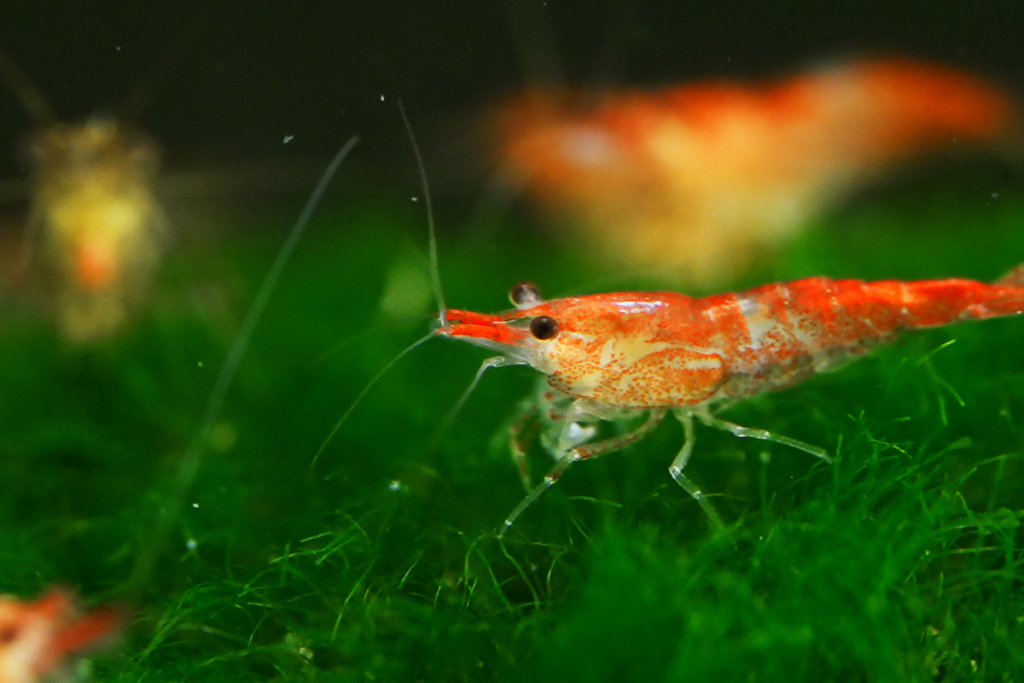
When I first started keeping Cherry Shrimp, I made the mistake of using a substrate that was too rough. It caused some of my shrimp to develop injuries and become stressed.
After switching to a finer substrate and providing more hiding places, my shrimp became much happier and healthier.
Remember, a well-planned tank setup can make all the difference in the world for your Cherry Shrimp!
Water Quality
When it comes to keeping your Cherry Shrimp healthy, maintaining good water quality is of utmost importance.
In this section, we’ll cover the three main factors that affect water quality: temperature, pH, and hardness.
We’ll also discuss the importance of regular water changes to keep your tank clean and healthy.
Water Temperature
Cherry Shrimp are sensitive to temperature changes, so it’s important to keep the water temperature stable.
The ideal temperature range for Cherry Shrimp is between 72°F and 82°F (22°C to 28°C).
If the water temperature drops below 68°F (20°C), your shrimp may become sluggish, and if it rises above 86°F (30°C), it can be fatal for them.
Water pH
The pH level of your tank water is also crucial for the health of your Cherry Shrimp.
The ideal pH range for Cherry Shrimp is between 6.5 and 8.0. If the pH level drops below 6.0, it can be harmful to your shrimp, and if it rises above 8.5, it can be fatal for them.
You can use a pH testing kit to regularly monitor the pH level of your tank water.
Water Hardness
Water hardness refers to the amount of minerals, such as calcium and magnesium, in the water. Cherry Shrimp prefer slightly hard water, with a range of 6 to 8 degrees of hardness.
If the water is too soft or too hard, it can cause health problems for your shrimp.
Water Changes
Regular water changes are essential for maintaining good water quality in your tank. You should aim to change 10-20% of the water in your tank every week.
This will help remove any toxins, waste, or excess nutrients that can build up in the water over time.
When doing a water change, make sure to use a water conditioner to remove any chlorine or chloramines that may be present in tap water.
Personally, I’ve found that maintaining good water quality is the key to keeping my Cherry Shrimp happy and healthy. By monitoring the temperature, pH, and hardness of the water, and doing regular water changes, you can create a clean and healthy environment for your shrimp to thrive in.
Tank Maintenance
Keeping your cherry shrimp healthy and happy requires regular tank maintenance. Here are some tips to help you keep your tank in top condition:
First, make sure to perform regular water changes. Aim for changing 10-20% of the water in your tank every week. This will help keep the water quality high and prevent the buildup of harmful toxins.
Next, keep an eye on your filter. Your filter is responsible for removing waste and debris from the water, so it’s important to make sure it’s working properly.
Clean or replace your filter media as needed, and make sure the flow rate is appropriate for your tank size.
Another important aspect of tank maintenance is monitoring the temperature and pH levels of the water. Cherry shrimp prefer a pH between 6.5 and 8.0, and a temperature between 70-78°F.
Use a thermometer and pH test kit to regularly check the levels and adjust as needed.
Finally, keep an eye out for any signs of illness or stress in your cherry shrimp. This could include lethargy, loss of appetite, or unusual behavior.
If you notice any of these signs, it’s important to take action quickly to diagnose and treat the problem.
Personally, I’ve found that keeping a regular maintenance schedule helps me keep my cherry shrimp healthy and happy. By performing regular water changes and keeping an eye on the filter and water parameters, I’ve been able to maintain a thriving shrimp colony in my own tank.
Tank Mates
If you want to keep Cherry Shrimp, it is essential to know which fish species can coexist with them in the same tank.
In this section, we will discuss the compatible and incompatible fish species with Cherry Shrimp and how many Cherry Shrimp should be kept together.
Compatible Fish Species
Cherry Shrimp are peaceful creatures and can coexist with various fish species. Some of the compatible fish species with Cherry Shrimp include:
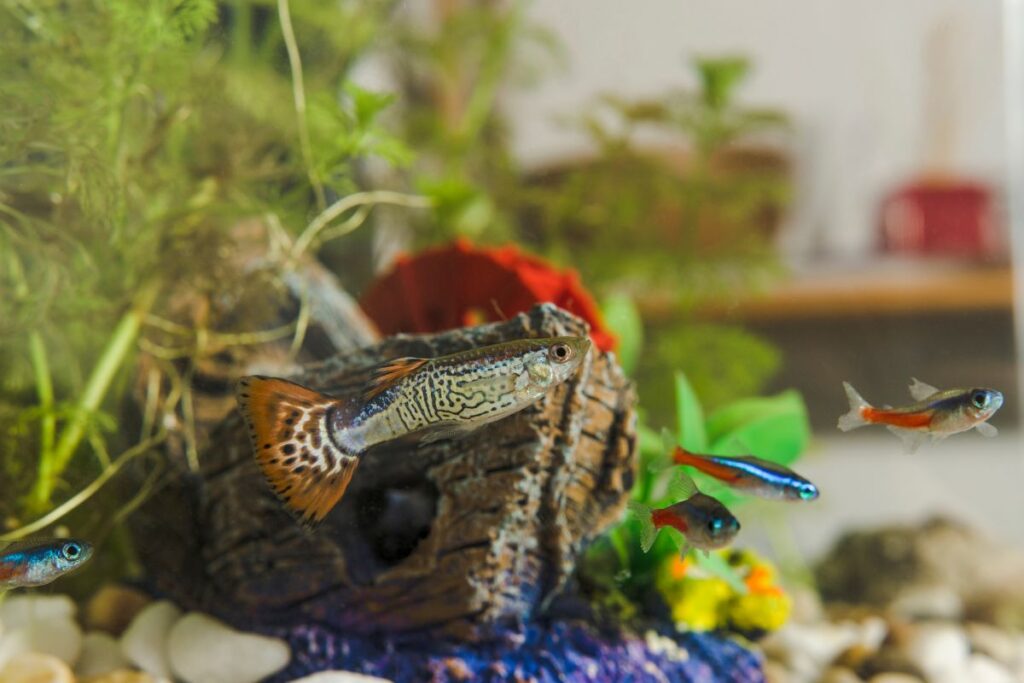
- Neon Tetras
- Otocinclus Catfish
- Corydoras Catfish
- Guppies
These fish species are peaceful and will not harm Cherry Shrimp. They also prefer similar water parameters, making them an ideal match for Cherry Shrimp.
Incompatible Fish Species
Some fish species should not be kept with Cherry Shrimp, as they pose a threat to their safety. These fish species include:
- Betta Fish
- Cichlids
- Angelfish
- Goldfish
These fish species are known to be aggressive and may attack and eat Cherry Shrimp. Therefore, it is best to avoid keeping them together.
How Many Cherry Shrimp Should Be Kept Together
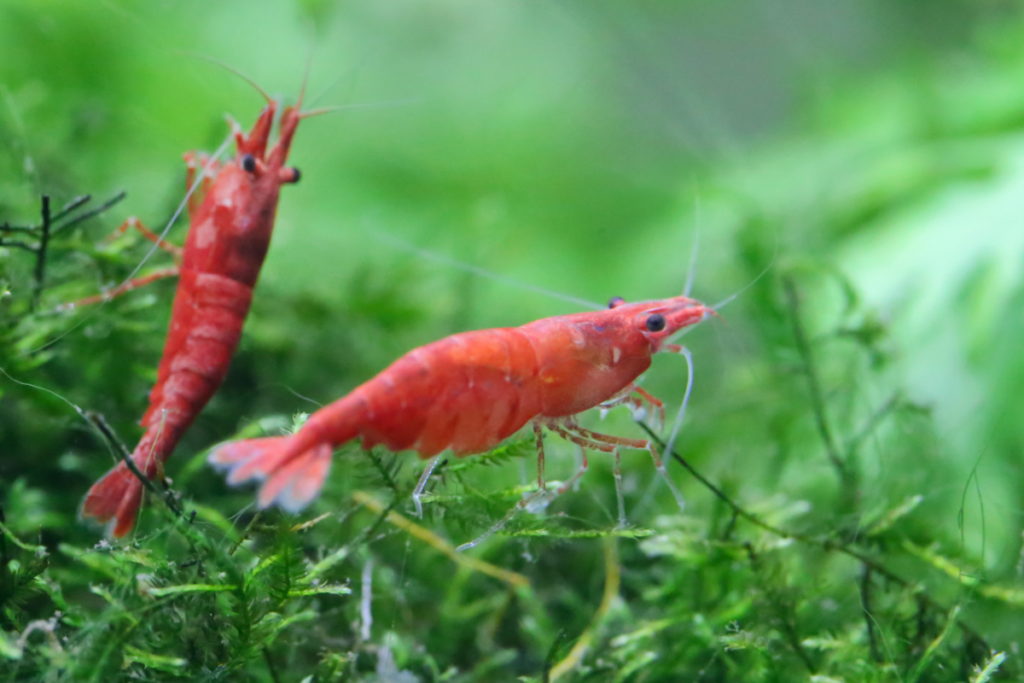
When keeping Cherry Shrimp, it is essential to know how many you should keep together in the same tank. A general rule of thumb is to keep at least five Cherry Shrimp together. This will help them feel more comfortable and reduce stress.
However, it is crucial to consider the size of your tank when deciding how many Cherry Shrimp to keep. As a general rule, you should keep one Cherry Shrimp per gallon of water.
So, if you have a 10-gallon tank, you can keep up to ten Cherry Shrimp.
Personal anecdote: When I first started keeping Cherry Shrimp, I made the mistake of keeping them with aggressive fish species. Unfortunately, I lost many Cherry Shrimp due to this mistake. After researching and learning about compatible fish species, I now keep Cherry Shrimp with Neon Tetras, and they coexist peacefully.
Diet
Proper diet is essential for the health and well-being of your Cherry Shrimp. Here we will discuss what to feed your shrimp, how often, and some tips to keep in mind.
What To Feed
Cherry Shrimp are omnivores and will eat algae, biofilm, and other microorganisms in their natural habitat. In captivity, they can be fed a variety of foods, including:
- Algae wafers
- Vegetables such as zucchini, spinach, and kale
- Protein-rich foods such as brine shrimp, bloodworms, and daphnia
- Specialized shrimp pellets or flakes
It’s important to provide a varied diet to ensure your shrimp receive all the necessary nutrients.
Frequency
Feed your Cherry Shrimp small amounts of food once or twice a day. Overfeeding can lead to health problems and water quality issues.
A good rule of thumb is to provide enough food that your shrimp can consume within 2-3 hours.
Tips
Here are some tips to keep in mind when feeding your Cherry Shrimp:
- Remove any uneaten food after a few hours to prevent it from decaying and polluting the water.
- Rotate the types of food you offer to ensure a balanced diet.
- Consider supplementing your shrimp’s diet with calcium-rich foods such as cuttlebone or specialized shrimp supplements to promote healthy molting.
Remember, a healthy diet is key to keeping your Cherry Shrimp happy and thriving!
Personally, I found that my Cherry Shrimp love blanched zucchini. I cut it into small pieces and drop it in the tank. They swarm around it and eat it up in no time. It’s a great way to provide them with some variety in their diet.
Common Diseases
Diseases
Cherry shrimp are generally hardy and resistant to diseases, but they can still fall ill.
Here are some common diseases that you should be aware of:
- Bacterial infections
- Fungal infections
- Parasitic infections
- Viral infections
Symptoms
If your cherry shrimp are sick, they will display certain symptoms. Here are some signs to look out for:
- Discoloration
- Loss of appetite
- Lethargy
- Erratic swimming
- Stress
- Death
Treatment
If you notice any of these symptoms, it’s important to act quickly to prevent the spread of disease. Here are some treatments that you can try:
- Antibiotics
- Anti-fungal medication
- Anti-parasitic medication
- Quarantine sick shrimp
Prevention
Prevention is always better than cure. Here are some steps that you can take to prevent diseases from affecting your cherry shrimp:
- Maintain clean water conditions
- Avoid overfeeding
- Quarantine new shrimp before introducing them to your tank
- Keep stress levels low
I remember when I first got into cherry shrimp keeping, I lost a few shrimp due to a bacterial infection.
It was a tough lesson to learn, but it taught me the importance of maintaining clean water conditions and being vigilant about any changes in my shrimp’s behavior.
By following the tips above, you can help keep your cherry shrimp healthy and happy.
Signs of a Healthy Cherry Shrimp
When it comes to keeping Cherry Shrimp, it’s important to know how to keep them healthy. Here are some signs to look for to make sure your shrimp are happy and healthy:
- Movement: Healthy Cherry Shrimp are active and move around a lot. If your shrimp are staying in one place for long periods of time, it could be a sign of stress or illness.
- Color: A healthy Cherry Shrimp should have a bright, vibrant color. If their color is faded or dull, it could be a sign of poor health.
- Antennae: The antennae of a healthy Cherry Shrimp should be long and straight. If they are curled or drooping, it could be a sign of stress or illness.
- Feeding: Healthy Cherry Shrimp are voracious eaters and will eagerly eat any food you give them. If your shrimp aren’t eating or seem uninterested in food, it could be a sign of poor health.
- Breathing: Cherry Shrimp breathe through their gills, and healthy shrimp will have a steady and rhythmic breathing pattern. If you notice your shrimp gasping for air or breathing heavily, it could be a sign of poor water quality.
Personally, I always keep a close eye on my Cherry Shrimp. I love watching them scuttle around my tank and seeing their vibrant colors. Whenever I notice any of these signs of poor health, I take immediate action to correct the problem. By keeping a watchful eye and taking good care of your Cherry Shrimp, you can ensure they live long and healthy lives.
Signs Your Cherry Shrimp Is Sick
If you’re a new cherry shrimp owner, it can be challenging to tell if your shrimp is sick. But don’t worry, we’ve got you covered! Here are some signs that your cherry shrimp may be sick:
- Discoloration: If your shrimp is turning white or brown, it could be a sign of a bacterial infection.
- Loss of Appetite: If your shrimp is not eating, it could be a sign of stress or illness.
- Erratic Swimming: If your shrimp is swimming erratically or upside down, it could be a sign of a bacterial infection or water quality issues.
- Abnormal Shedding: If your shrimp is not shedding properly, it could be a sign of a calcium deficiency or other health issues.
If you notice any of these signs, it’s essential to take action immediately. Sick shrimp can infect other shrimp in the tank and even lead to death.
When I first started keeping cherry shrimp, I noticed one of my shrimp wasn’t eating and was swimming erratically.
I was worried, so I did some research and found out that it was likely due to poor water quality. I did a water change, and within a few days, my shrimp was back to normal.
It’s crucial to monitor your shrimp’s behavior and take action if you notice anything unusual.
Breeding
Breeding Setup
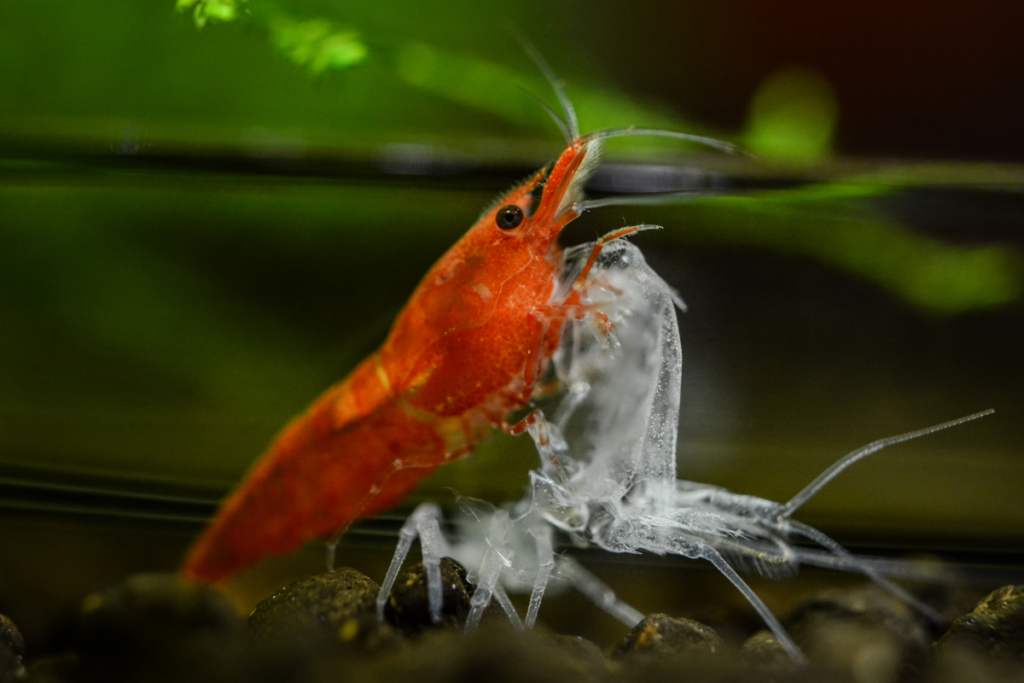
To breed Cherry Shrimp, you need to set up a breeding tank. A 10-gallon tank is a good size for breeding Cherry Shrimp. You will need a sponge filter, a heater, and a substrate.
The sponge filter is important because it provides a gentle current and helps keep the water clean. The heater will keep the water at a consistent temperature, which is important for breeding.
The substrate should be fine-grained, like sand or gravel, to provide a good surface for the shrimp to lay their eggs.
How To Breed
Breeding Cherry Shrimp is relatively easy. Once you have your breeding tank set up, you can add a few males and females.
The males will chase and court the females, and eventually, the females will lay eggs. The eggs will hatch in about 20-30 days, and the baby shrimp will be tiny and transparent.
One thing to keep in mind when breeding Cherry Shrimp is that they require stable water parameters. Make sure to test the water regularly and do water changes as needed to keep the water clean and stable.
Care
Once the baby shrimp hatch, they will need to be fed. You can feed them powdered spirulina or crushed fish flakes.
As they grow, you can start feeding them small pieces of blanched vegetables, like zucchini or spinach. It’s important to keep the breeding tank well-maintained to ensure the health of the shrimp.
Make sure to do regular water changes and keep the water parameters stable. Also, be sure to remove any dead shrimp or uneaten food promptly to prevent water quality issues.
I have personally found breeding Cherry Shrimp to be a rewarding and enjoyable experience. Watching the tiny shrimp grow and develop is fascinating, and it’s always exciting to see new babies hatch.
With a little bit of care and attention, you can successfully breed Cherry Shrimp in your own home aquarium.
Product recommendations for Cherry Shrimp:
- Hikari Shrimp Cuisine – This is a high-quality shrimp food that is perfect for Cherry Shrimp. It contains all the essential nutrients that your shrimp need to stay healthy and vibrant.
- API Aquarium Water Test Kit – It is important to keep an eye on the water quality in your aquarium, and this test kit makes it easy to do so. It includes tests for ammonia, nitrite, nitrate, and pH.
- Salty Shrimp Bee Shrimp Mineral GH+ – This is a mineral supplement designed specifically for Cherry Shrimp. It provides the essential minerals and trace elements that your shrimp need to thrive.
- Fluval Plant and Shrimp Stratum – If you plan on keeping live plants in your aquarium, this substrate is a great choice. It provides the nutrients that plants need to thrive, and also helps to maintain a stable pH.
- AquaClear Power Filter – This filter is highly effective at removing debris and maintaining water quality in your aquarium. It is also very quiet and easy to maintain.
- Aqueon Aquarium Water Changer– This device makes it easy to perform regular water changes in your aquarium. It is designed to be safe and easy to use, and can help to keep your Cherry Shrimp healthy.
- Zoo Med Nano 10 External Canister Filter – This is a small and efficient filter that is perfect for smaller aquariums housing Cherry Shrimp. It is easy to install and maintain, and will keep the water in your aquarium clean and healthy.
- NICREW ClassicLED Aquarium Light – This LED light is perfect for illuminating your aquarium and showcasing your Cherry Shrimp. It is energy-efficient and easy to install.
- Marimo Moss Balls – These are a great addition to any shrimp tank, including one housing Cherry Shrimp. They provide a natural habitat for shrimp and help to maintain water quality.
Conclusion
Caring for Cherry Shrimp can be a rewarding and enjoyable experience. By following the tips and guidelines outlined in this article, you can create a healthy and thriving environment for your shrimp.
Remember to keep the water parameters consistent and within the appropriate range, provide a varied and nutritious diet, and maintain a clean and well-maintained tank. Additionally, it is important to monitor your shrimp for any signs of illness or stress and take appropriate action if necessary.
Overall, Cherry Shrimp are a great addition to any aquarium and can bring a pop of color and personality to your tank. With a little bit of effort and care, you can provide your shrimp with a happy and healthy home.
Personally, I have found that caring for Cherry Shrimp has been a fun and rewarding experience. I love watching them explore their environment and interact with each other. It’s amazing to see how much personality they have, despite being such small creatures.
So, if you’re considering adding Cherry Shrimp to your aquarium, go for it! With the right care and attention, you can create a beautiful and thriving ecosystem for these fascinating creatures.
FAQs
Here are some frequently asked questions about Cherry Shrimp care:
Q: Can I keep Cherry Shrimp with other fish?
A: Yes, Cherry Shrimp are generally peaceful and can be kept with other small, non-aggressive fish. However, be careful with larger fish that may view the shrimp as prey.
Q: How often should I feed my Cherry Shrimp?
A: Cherry Shrimp are scavengers and will eat almost anything, including algae and leftover fish food. Feed them small amounts of food once or twice a day, and remove any uneaten food after a few hours.
Q: What is the ideal water temperature for Cherry Shrimp?
A: Cherry Shrimp prefer a water temperature between 72-78°F (22-26°C). Make sure to keep the water parameters stable and avoid sudden changes in temperature or pH.
Q: How often should I clean my Cherry Shrimp tank?
A: It’s important to maintain good water quality for your Cherry Shrimp. Do partial water changes of 10-20% every week or two, and clean the substrate and decorations as needed. Avoid using any chemicals or cleaners that may harm the shrimp.
Q: Can I breed Cherry Shrimp in my tank?
A: Yes, Cherry Shrimp are prolific breeders and can multiply quickly in a suitable environment. Provide plenty of hiding places and a healthy diet to encourage breeding. I once had a Cherry Shrimp tank that started with just a few shrimp, and soon there were dozens of babies crawling around!
Reference: Wikipedia.
